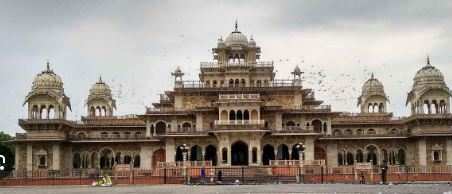You will find statues of 65 saints of the country at one place in Rajasthan, decide for yourself by watching the video
Rajasthan News Desk !!! You will also agree with this fact that old things have a different significance. History and its knowledge always attracts our mind. There is such a unique centre of world history in the Pink City Jaipur which reveals many secrets to us not only of Rajasthan or India but also of the world's oldest civilizations.
The 150-year-old Albert Hall, located in the center of Jaipur city, holds within itself the secrets of the world's oldest civilization, Egypt, along with the history of Rajasthan and the architecture of the British, which will surprise you. The main attraction here is the 2300-year-old mummy brought from Egypt, this mummy belongs to Tutu, a woman from the priest family of the Egyptian royal family, many remains of which are still safe today.
We are talking about Jaipur's largest and oldest museum, Albert Hall, which was built by Maharaja Ram Singh. Standing as the epitome of Indo-Saracenic architecture, this building was named after the Prince of Wales, Albert Edward. Adorned with lush gardens, the foundation of Albert Hall was laid on 6 February 1876, when Albert Edward visited India. The museum galleries have a collection of antiques and artifacts from the past that will amaze you. Ancient coins, marble art, pottery, carpets and especially Egyptian mummies are kept here, which is one of the most attractive places in Jaipur for history buffs as well as tourists to visit, so let us make you familiar with the history, architecture, structure of Albert Hall Museum, when and who built it and the best time to visit here.
The history of Albert Hall in Jaipur is about 150 years old, the foundation of which was laid on 6 February 1876 during the visit of Prince of Wales Albert Edward to Jaipur. And this building is named after him. Maharaja Sawai Ram Singh wanted Albert Hall to be a town hall, while some ministers suggested using it for cultural or educational purposes. After which, on the suggestion of Maharaja Sawai Madho Singh II in 1880, it was made a temporary museum in 1881 to display the art of local artisans. The construction of Albert Hall was completed in 1887 by Samuel Swinton Jacob, Director of Jaipur PWD. Sir Edward Bradford formally inaugurated it in 1887. About Rs 5,01,036 was spent in building this magnificent building. In the year 2008, the biggest reconstruction of this museum was done till date.
Albert Hall is a splendid example of Indo-Saracenic architecture. Its corridors are decorated with murals in a variety of styles, depicting European, Egyptian, Chinese, Greek and Babylonian civilizations. Ancient coins, marble art, pottery, carpets and especially mummies brought from Egypt are kept here. Albert Hall has many interesting galleries, which exhibit objects and treasures from the nineteenth century to ancient times. So let's go inside the Albert Hall Museum and start turning the pages of history where what attracts us the most is Tutu's mummy.
Egyptian Mummy, one of the most prestigious historical collections in the museum is the Egyptian Mummy, which attracts tourists. This mummy gives us very important information about the pyramids of Giza, the civilization of the Nile River and the amazing process of preserving the dead bodies of ancient Egypt in the form of mummies. The 2300-year-old mummy kept here is of Tutu, a woman from the priest family of the royal family of Egypt, who was converted into a mummy in the time of 322 BC. This mummy was brought to Jaipur by the British government from Cairo city of Egypt in the 19th century in the year 1880. Along with Tutu's mummy, 399 historical objects related to the Egyptian civilization were also brought to Jaipur. Which display the gods and goddesses, civilization, food, costumes, customs of Egypt.


Comments are closed.